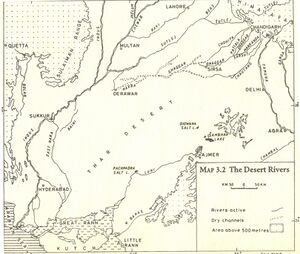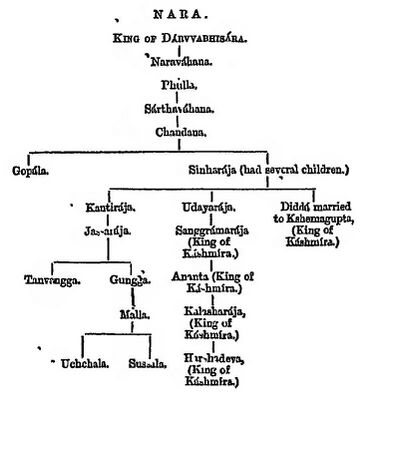Nara
Nara (नारा)[1] [2] is gotra of Jats in Haryana, Uttar Pradesh and Madhya Pradesh. Nara clan is found in Afghanistan also. [3]
Nara I (1023-983 BC) was king of Kashmir.[4]
Nara II (520 BC-460 BC) was king of Kashmir.[5]
Origin
- The clan Nara may be said to be originated from King named Nara of Kashmir.
- This gotra is said to be originated from Greek word Naraya (नाराय). [6]
History

Mor and Nara (नारा) are mentioned as Mura and Naraka (नरक)[7] – two powerful “ Yavana” Kings, who were ruling over the Mura and Naraka along with Varuna in the western countries. [8] Also compare Maru and Nairi of Assyrians inscriptions. [9]
H.A. Rose[10] writes that Karral (कर्राल), a tribe found only in Hazara. According to the late Colonel H. G. Wace " the Karral country consists of the Nara ilaqa in Abbottabad tahsil. The Karrals were formerly the subjects of the Gakkhars, from whom they emancipated themselves some two centuries ago.
King named Nara of Kashmir
Rajatarangini[11] mentions in the list of Kings of Kashmir one Nara I, King of Darvabhisara: Then came his son Nara I, sometimes called Kinnara, to the throne. Whatever he did for the benefit of his subjects turned, from want of proper judgment, to their injury. A Buddhist who lived in a monastery in a certain village eloped with his queen, this so enraged him, that he burnt thousands and thousands of monasteries, and gave to the Brahmanas, who dwelt at Madhyamata, the villages that supported those monasteries. He built a town on the banks of the Vitasta, which he laid out with spacious roads, and adorned with the spoils of other countries. It was crowded with rich shops, and graced with fruit and flower gardens, and the river below was covered with boats.
Rajatarangini[12] mentions that the passion Nara I suffered what none over suffered. When a king, under the pretence of protecting his subjects, oppresses them, he generally meets such a death unawares. Even to this day, the burnt houses and the tank near the hill Chakradhara remind the people of the occurrence. This king reigned over a period of thirty-nine years and nine months, and within this short time the town of Kinnarapura (Narapura) became as beautiful as Gandharvapura. It was by mere chance that Nara's son prince Sidha was absent at Vijayakshetra when the catastrophe happened to the king and his capital, and thus his life was saved from the general ruin.
Rajatarangini[13] mentions a place called Narapura.
Genealogy of Nara
Rajatarangini[14] provides us following Genealogy of Nara:

Formerly at Darvvabhisara there lived a king named Nara of the Gotra of Bharadvaja, who had a son named Naravahana, and Naravahana had a son named Phulla. Phulla had a son named Sarthavahana, his son was Chandana, and Chandana had two sons, Gopala and Sinharaja, Sinharaja had several children, his daughter Didda was married to Kshemagupta. Didda made Sanggramaraja (son of her brother Udayaraja) king. She had another brother, Kantiraja, and he had a son named Jassaraja, Sanggramaraja had a son named Ananta, while of Jassaraja were born Tanvangga and Gungga. Ananta's son was Kalasharaja, and of Gungga was born Malla. Kalasha's son is king Harshadeva, and Malla's sons were Uchchala and Sussala.
Distribution in Madhya Pradesh
Villages in Narsimhapur district
Distribution in Haryana
Villages in Jhajjar district
Villages in Gurgaon district
Villages in Jind District
They are also settled in the village Naguran in Jind district Haryana, where they are known as "Mirdha". Mandana,
Villages in Ambala district
Bhukhri, and in nearby villages as well.
Villages in Jind district
References
- ↑ Jat History Dalip Singh Ahlawat/Parishisht-I, s.n. 44
- ↑ O.S.Tugania:Jat Samuday ke Pramukh Adhar Bindu,p.47,s.n. 1392
- ↑ An Inquiry Into the Ethnography of Afghanistan, H. W. Bellew, p.109
- ↑ Rajatarangini of Kalhana:Kings of Kashmira/List of Kings,p.xx
- ↑ Rajatarangini of Kalhana:Kings of Kashmira/List of Kings,p.xx
- ↑ Dr Mahendra Singh Arya etc,: Ādhunik Jat Itihas, p. 260
- ↑ Mahabharata Sabha Parva, Book 2, Section IX
- ↑ Mahabharata Sabha Parva, 13 / 13
- ↑ Bhim Singh Dahiya, Jats the Ancient Rulers ( A clan study), 1980, Sterling Publishers New Delhi , p. 287
- ↑ A glossary of the Tribes and Castes of the Punjab and North-West Frontier Province By H.A. Rose Vol II/K,p.477
- ↑ Rajatarangini of Kalhana:Kings of Kashmira/Book I,p.15
- ↑ Rajatarangini of Kalhana:Kings of Kashmira/Book I,p.17
- ↑ Rajatarangini of Kalhana:Kings of Kashmira/Appendix B, p.iv
- ↑ Rajatarangini of Kalhana:Kings of Kashmira/Book VII (i), pp. 266-267
Back to Jat Gotras

